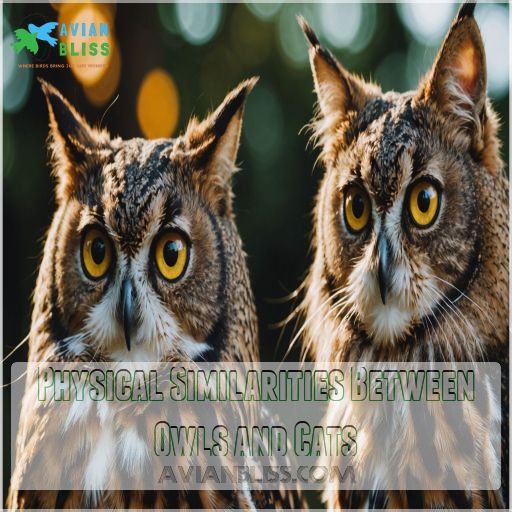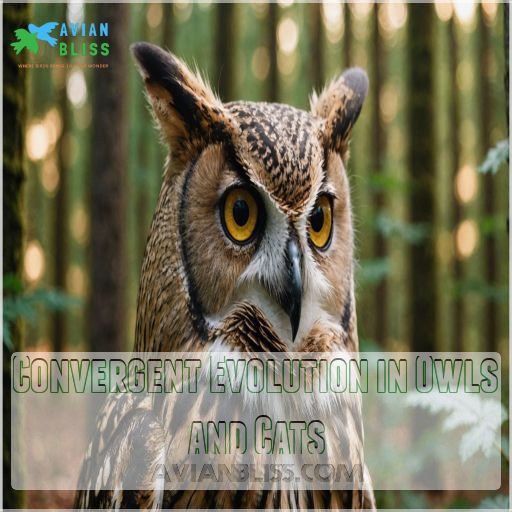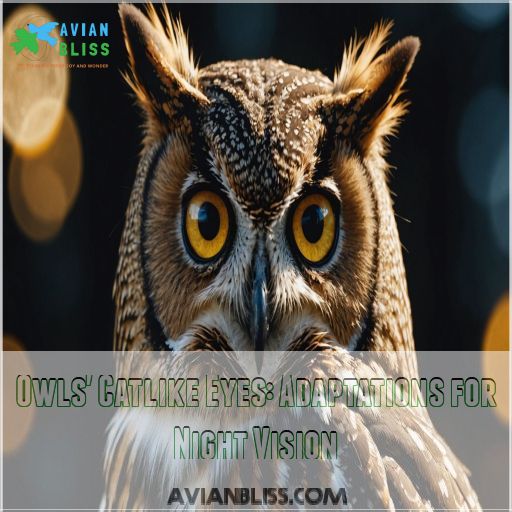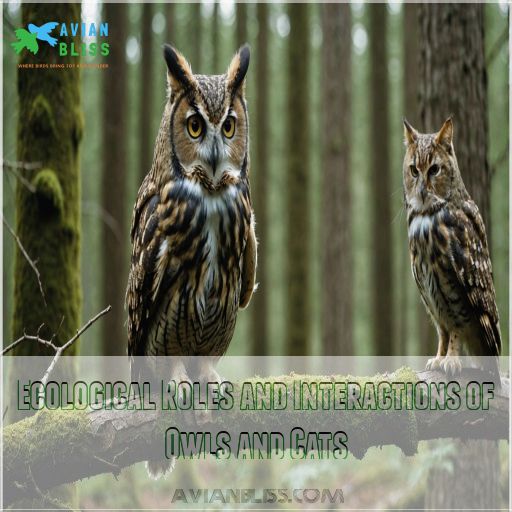This site is supported by our readers. We may earn a commission, at no cost to you, if you purchase through links.

Both have large, forward-facing eyes that give them excellent depth perception and night vision. Their flat faces and short muzzles contribute to that intense, focused gaze you’ve probably noticed.
Owls and cats even have similar hunting styles, relying on stealth and surprise to catch their prey.
This resemblance isn’t just a coincidence – it’s a result of convergent evolution, where different species develop similar traits to adapt to similar environments. But there’s more to this owl-cat connection than meets the eye…
But there’s more to this phenomenon, as it’s also influenced by the fact that both are nocturnal creatures.
Table Of Contents
- Key Takeaways
- Physical Similarities Between Owls and Cats
- Convergent Evolution in Owls and Cats
- Owls’ Catlike Eyes: Adaptations for Night Vision
- Shared Nocturnal Lifestyle and Predatory Behavior
- Adaptive Advantages of Owls’ Catlike Appearance
- Similar Hunting Techniques of Owls and Cats
- Sensory Perception Similarities in Owls and Cats
- Communication and Social Behavior Parallels
- Unique Features Contributing to Catlike Appearance
- Ecological Roles and Interactions of Owls and Cats
- Frequently Asked Questions (FAQs)
- Conclusion
Key Takeaways
- You’re not seeing things – owls and cats really do share some striking similarities. Both have large, forward-facing eyes that give them excellent depth perception and night vision, as well as flat faces and short muzzles that contribute to their intense, focused gaze.
- It’s all about that nightlife – owls and cats are both nocturnal predators, so they’ve evolved similar adaptations for hunting in the dark. Their shared traits, like acute hearing and stealthy movements, are nature’s way of saying "You snooze, you lose" to their prey.
- Talk about a game of copycat. The resemblance between owls and cats is a perfect example of convergent evolution. It’s as if nature decided to outfit these nighttime ninjas with the same stealth gear, even though they’re not closely related.
- Don’t let their looks fool you – while owls might look like cats with wings, they’ve got some unique, owl-some features of their own. From their ability to turn their heads nearly all the way around to their silent flight, owls have some tricks up their feathery sleeves that even the craftiest cat would envy.
Physical Similarities Between Owls and Cats
If you’ve ever thought an owl looked a bit like a cat in a bird costume, you’re not alone!
These two creatures share forward-facing eyes, sharp claws, and flat faces, making them surprisingly similar despite their different places in the animal kingdom.
Forward-facing Eyes for Depth Perception
Ever noticed how both owls and domestic cats share that intense, forward-facing gaze? It’s not just for show—it’s all about binocular vision, giving both these predators a 3D perception advantage.
This depth perception boosts their ability to detect prey, especially at night.
It’s a predator advantage they’ve got through convergent evolution, enhancing their facial structure, including facial discs.
Sharp Claws for Hunting
Owls and cats share a surprising ability to hunt with sharp claws, making them nature’s stealthy predators.
These claws offer:
- Claw size: Perfect for gripping slippery prey.
- Hunting strategy: Enhance silent stalking and pouncing.
- Prey adaptations: Enable swift, precise captures.
Both use evolutionary benefits ensuring hunting success, echoing why owls might remind you of cats.
Flat Face and Short Muzzle
Let’s chat about facial structure. Both owls and cats sport a flat face and short muzzle, which contribute to an intense, focused gaze.
This setup isn’t just for looks; it offers a hunting advantage. With sensory function sharpened by evolutionary pressure, these features help in prey capture.
Their expressions might also get you thinking, "Who’s plotting world domination now?
Compact Build With Long Tail
A compact build paired with a long tail gives both owls and cats their renowned agility and camouflage advantage.
This sleek design aids in moving through tight spaces and disappearing into their surroundings—a must when you’re on the hunt.
Surprisingly, their tail length variation isn’t just for balance; it’s a clever evolutionary response to shared predatory pressures.
Soft, Dense Coat for Insulation
While owls mightn’t boast a long tail, they’ve got soft, dense feathers providing insulation similar to a cat’s fur.
Both adaptations help regulate heat and provide camouflage.
These insulating layers serve as an evolutionary advantage in cold weather, letting each predator blend into their environment, sneak up on prey, and survive in diverse habitats (Source), which is an evolutionary advantage.
Convergent Evolution in Owls and Cats
Have you ever noticed the striking similarities between owls and cats?
It turns out these uncanny resemblances are the result of a fascinating evolutionary phenomenon known as convergent evolution.
Let’s explore why these two very different species have developed such remarkably similar physical traits, which is a result of striking similarities.
Shared Environmental Pressures
So, you’ve wondered why owls and cats have that uncanny resemblance? It’s nature’s game of copycat!
They faced similar evolutionary pressures, like predator-prey dynamics and habitat selection, which pushed them to adapt in strikingly similar ways.
These adaptation strategies emerged from their overlapping environmental niches, boosting their survival with catlike looks and abilities.
Evolution sure has a sense of humor!
Adaptation to Nocturnal Hunting
In the dance of evolution, both owls and cats have mastered the art of moving silently through the night.
With acute hearing and sound localization, these nocturnal hunters meld into shadows, embodying nature’s camouflage strategies.
They’ve honed sensory adaptations to catch prey unaware, facing evolutionary pressures head-on as if they’re actors in a dramatic play of survival .
Development of Similar Visual Adaptations
If you’ve ever thought owls were the feline lookalikes of the bird world, you’re onto something! Similar evolutionary pressures have sculpted their eye structures, boosting visual acuity with high rod cell density for light sensitivity.
This gives them:
- Amazing night vision
- Forward-facing eyes
- Large, immovable sockets
- Heads that swivel like a radar
- Catlike perception prowess
It’s nature’s night owl-game!
Independent Evolution of Shared Traits
You might wonder why owls and cats look like they’re cut from the same cloth.
Driven by evolutionary pressures and natural selection, both adapted to shared environments, achieving similar traits through convergent evolution. This isn’t mimicry adaptation, but independent paths converging. It’s as if nature handed them the same recipe, only to bake unique cookies!
| Trait | Owls | Cats |
|---|---|---|
| Vision | Night vision | Night vision |
| Hunting Style | Stealthy pounce | Stealthy pounce |
| Sensory Feature | Acute hearing | Acute hearing |
Owls’ Catlike Eyes: Adaptations for Night Vision
When you first peek into an owl’s mesmerized gaze, you might wonder if it’s your cat in disguise, but their eyes have evolved to excel in the dark.
While owls can’t roll their eyes like a drama queen, their heads do all the spinning, giving them a clear advantage in spotting prey even in the moonlight.
Large, Forward-facing Eyes
Imagine this: owls, armed with large, forward-facing eyes, peer into the dark like seasoned detectives.
These eyes, a marvel of predator vision, offer stunning depth perception and binocular vision, making owls masters of the night.
With eyes as big as their ambitions, they’ve aced the evolution game, providing a formidable advantage in the hunt for prey.
Enhanced Light Sensitivity
Owls’ eyes are truly remarkable – packed with rod cells that soak up even the faintest moonlight, allowing them to see up to 100 times better than humans in low light.
This is thanks to their ability to see ultraviolet light, which helps them spot urine trails of small mammals invisible to humans owl sensory adaptations.
This specialized retinal structure, combined with their enlarged corneas, allows owls to see with incredible clarity in the dark.
No wonder they can hunt so effectively at night, like feline predators with their own catlike night vision superpowers!
Specialized Retinas for Low-light Conditions
When you’re thinking about night vision, imagine an owl’s eyes: evolution designed them perfectly for low-light hunting.
These eyes are packed with rod cells, the masters of light sensitivity, making sure they don’t miss a thing in the dark.
It’s like having built-in "luxury night vision goggles," ensuring they spot midnight snacks effortlessly (Source).
Immobile Eye Sockets Compensated by Head Rotation
Owls mightn’t roll their eyes like you can, but they make up for it with amazing head rotation. Their eyes are fixed; they can’t just glance sideways.
Instead, they twist their necks up to 270 degrees to see better.
This head-turning agility is a fascinating aspect of owl vision and predatory adaptations.
Shared Nocturnal Lifestyle and Predatory Behavior
Have you ever wondered why owls and cats seem like nature’s night-club bouncers, lurking in the shadows?
Their knack for nocturnal prowling, with those specialized, wide-eyed stares and stealthy moves, makes them expert nighttime hunters, utilizing their specialized, wide-eyed stares for hunting.
Active Primarily at Night
Under the cloak of darkness, both owls and cats navigate their nocturnal world with remarkable grace.
Equipped with night vision and other nocturnal adaptations, these hunters have turned moonlit landscapes into their playground, utilizing their exceptional low light vision abilities
.
Their hauntingly still pursuit of prey—silent as a whisper—reveals an artful dance of sensory perception and predator-prey relationships, mesmerizing nature’s theater.
Specialized Eyes for Night Vision
Picture yourself on a moonlit night, marveling at nature’s wonders.
Owl eyes, much like cat eyes, have evolved for nocturnal adventures. Their large, forward-facing structure enhances depth perception, maximizing light intake.
An abundance of rod cells boosts their sensitivity to dim light, separating their night vision from day-oriented cones. It’s an evolutionary masterpiece of seeing in the dark.
Stealthy Hunting Techniques
Owls and cats share stealthy hunting techniques, leveraging their silent flight and agility to pursue prey undetected.
By flying silently, owls can sneak up on unsuspecting prey, while their acute hearing and exceptional night vision allow them to pinpoint and capture small animals with ease, utilizing their silent flight to their advantage.
Silent Flight and Agility in Pursuit
When you think of owls swooping down on unsuspecting prey, their silent flight is a marvel of design.
The unique structure of their wings, with serrated feathers and fringed edges, breaks up air turbulence, making them masters of stealth.
This aerodynamic design lets owls execute silent hunting strategies and evasive maneuvers with unmatched precision, utilizing stealth strategies.
Adaptive Advantages of Owls’ Catlike Appearance
You may be wondering, "Why do owls look so much like cats?"
As it turns out, owls’ catlike appearance provides them with some surprising adaptive advantages.
From blending seamlessly into their surroundings to intimidating potential adversaries, owls’ feline features give them an edge in the wild, allowing for surprising adaptive advantages.
Camouflage for Blending Into Surroundings
Owls’ coloration helps them blend into their forest surroundings, like cat fur patterns in tall grass.
This trickiness aids nocturnal adaptations, making them unseen by both prey and predators.
In predator-prey interactions, their camouflage offers an edge, allowing:
- Background matching for stealth.
- Disruptive coloration to confuse predators.
- Shadow distortion through anti-silhouette strategies.
Intimidation of Potential Adversaries
Imagine this: you’re strolling through the woods, and you spot an owl with its catlike eyes glaring at a potential adversary.
Those enigmatic features aren’t just for show; they’re a survival tactic! By mimicking a feline stare, owls can ward off threats, making predators think twice. It’s Mother Nature’s way of saying, “Scare them before they scare you!”
| Feature | Owl | Cat |
|---|---|---|
| Eyes | Forward-facing | Forward-facing |
| Hunting | Silent, swooping | Stealthy, pouncing |
| Ears | Tufts (some species) | Upright, pointed |
| Behavior | Nocturnal, solitary | Nocturnal, independent |
| Threat | Intimidation tactics | Fierce stare down |
Access to Less Threatening Areas
So, you’ve seen how owls’ catlike appearance can freak out other animals, but there’s another trick up their sleeve!
By looking like cats, owls can slip into areas that are usually off-limits to them, giving them a sneaky advantage.
Think about it:
- A cat sneaking into a chicken coop? No problem!
- A cat lounging in a garden? Totally normal!
- An owl doing the same? That’s a different story!
Owls can blend in with cats, accessing areas that would otherwise be too risky for them.
Enhanced Hunting Abilities
Imagine an owl, all camouflaged and nestled.
While accessing less threatening areas, they wield their hunting prowess with remarkable efficiency.
With silent flight and keen hearing, they approach prey stealthily.
Those sharp beaks and powerful talons? They’re nature’s secret weapons.
It’s like having ninja skills in a feathery body suit, ready for the ultimate surprise attack.
Similar Hunting Techniques of Owls and Cats
In the moonlit world of owls and cats, their hunting strategies seem to follow a similar script.
You’ll find these nighttime prowlers using stealth and patience, surprising prey with pounces that rival the best of feline hunters.
Stalking and Pouncing Strategies
Owls and cats embody stealthy hunters with similar stalking and pouncing strategies. Both rely on silent flight and careful ambush tactics, ensuring prey detection without alerting their target.
Their nocturnal adaptations enable them to spot potential meals through sharp vision and acute hearing.
It’s like a natural game of hide and seek, where patience is the ultimate secret weapon.
Use of Surprise in Attacks
Moving from stalking to the art of surprise attacks, both owls and cats utilize silent hunting tactics to catch their prey off guard.
With their acute hearing and night vision, these ambush predators pounce unexpectedly, leaving unsuspecting victims in a state of… well, surprise!
Their stealth tactics make every hunt a strategic game of cat—and owl—versus mouse.
Reliance on Stealth and Patience
Silent hunting isn’t just for owls; cats embrace it too. Both rely on patience and stealth, using camouflage and ambush tactics to surprise their prey.
Here’s how they master the waiting game:
- Patient Stalking: Approach prey slowly, remaining unseen.
- Silent Movement: Avoid noise that could alert prey.
- Perfect Timing: Strike when least expected.
Adaptations for Capturing Small Prey
Ever notice how cats and owls share some sneaky moves? Both creatures excel at ambush tactics, utilizing silent flight or tiptoeing steps to take unsuspecting prey by surprise. Their sharp talons or claws are perfect for the final strike.
| Feature | Cats | Owls |
|---|---|---|
| Movement | Silent steps | Silent flight |
| Attack Method | Pouncing | Swooping |
| Weapon | Sharp claws | Sharp talons |
Sensory Perception Similarities in Owls and Cats
When you think about night vision and acute hearing, owls and cats might top your list of nature’s best listeners and seers.
These creatures have honed their sensory skills so well that even the faintest rustle or shadow doesn’t stand a chance, thanks to their acute hearing.
Excellent Night Vision Capabilities
In their quest for midnight snacks, both cats and owls boast superior night vision, thanks to evolution’s handy toolkit.
- Rod cell density: Packed with rods, these eyes devour darkness.
- Pupil dilation: Owls enlarge eyes for maximum capture.
- Tapetum lucidum: Provides a second chance for light.
- Light sensitivity: Owls are 100 times more sensitive than humans.
Acute Hearing for Locating Prey
Regarding sound localization, owls and cats are the rock stars of the animal kingdom.
Thanks to their keen ear structures, these creatures detect the slightest auditory cues, making prey detection a breeze.
Their hunting strategies rely on perfect pitch to swoop or pounce when it counts, showcasing nature’s clever design in action.
Facial Features Enhancing Sound Reception
Owls don’t just turn heads with their appearance; their facial features are like nature’s high-tech headphones.
The heart-shaped facial disc acts like a satellite dish, channeling sounds toward asymmetrical ears for pinpoint accuracy in sound localization (Source).
Enjoy the wisdom of owls with these traits:
- Facial disc function amplifies sound.
- Asymmetrical owl ear placement aids depth.
- Leads to superior predator-prey dynamics.
Sensitivity to Movement and Vibrations
You might be surprised to learn that owls and cats share a keen sensitivity to movement and vibrations – a key adaptation for their shared nocturnal hunting lifestyles.
Like a cat’s whiskers, an owl’s facial disc and asymmetrical ears allow it to detect the slightest rustle or scurry of potential prey. This heightened sensory awareness gives both predators a significant advantage when stalking their quarry in the dark.
| Sensory Cue | Owls | Cats |
|---|---|---|
| Movement | Detect even slight movements in leaves/undergrowth | Sensitive to vibrations through whiskers |
| Vibrations | Asymmetrical ear placement enhances vibration detection | Whiskers pick up subtle ground/air vibrations |
| Sound | Acute hearing in 0.5-10 kHz range to locate prey | Similar hearing sensitivity to owls in lower frequencies |
| Vision | Large, forward-facing eyes provide excellent night vision | Vertical slit pupils adapt to low light conditions |
| Stealth | Silent flight enables surprise attacks on unsuspecting prey | Stealthy movements and pouncing techniques |
Communication and Social Behavior Parallels
You’ll find that owls and cats both have fascinating ways of communicating, using vocalizations and body language to mark their territory and express intentions.
While they’re often solitary, these clever creatures occasionally engage in social interactions, showing off their unique personalities.
Vocalizations for Territory Marking
Imagine this: owl calls echoing like a soft symphony under the moon, akin to cat meows but with mysterious sound patterns of Georgia Owl Sounds
.
They aren’t just serenades; these vocalizations are territory defense mechanisms—predator warnings wrapped in nature’s soundtrack.
Their lyrical hoots might seem like nighttime performances, yet they’re critical for communicating with rivals and announcing their domain’s sovereignty.
Body Language for Expressing Intentions
Imagine an owl giving you the side-eye—it’s a masterful communicator. Owls express intentions through their body language, using vocalizations as well as subtle cues like tail movements and ear positions.
Watch for these signs:
- Tail flicks
- Subtle wing adjustments
- Poised body postures
- Feather fluffing
- Strategic silence
These behaviors keep misunderstandings at bay in the animal kingdom.
Use of Facial Expressions
Owls, like you at a family reunion, use facial expressions as communication signals to navigate predator-prey dynamics and social interactions.
These expressions can convey emotional cues, enhancing their silent communication.
While not as expressive as humans, an owl’s subtle changes in features play a key role in their world, much like a raised eyebrow at an awkward joke.
Solitary Nature With Occasional Social Interactions
During quiet nights, owls enjoy their solitude but exhibit fascinating social interactions.
You might spot them:
- Breeding Season: They engage in amusing courtship dances and vocal duets.
- Territory Defense: With dramatic hoots and wing displays, they assert dominance.
- Communication Signals: Using a mix of screeches and hisses, they expertly convey intentions.
Their occasional social flair adds charm to their mysterious lives.
Unique Features Contributing to Catlike Appearance
Have you ever wondered why owls seem to share so many physical traits with cats?
From their facial discs that resemble cat faces to their tufted ears, owls possess a number of unique features that contribute to their catlike appearance.
Let’s explore these surprising similarities that make owls nature’s feline doppelgängers.
Owls’ Facial Discs Resembling Cat Faces
Nature’s copycats are at it again! You’ve probably noticed how an owl’s face bears an uncanny resemblance to your feline friend’s.
This facial disc isn’t just for show – it’s a highly evolved feature that helps owls pinpoint sounds with incredible accuracy.
The round shape and feather arrangement create a parabolic reflector, channeling sound waves to their ears.
It’s like having built-in satellite dishes for ears!
Tufted Ears in Some Owl Species
Peering closer at certain owl species, you’ll notice their distinctive ear tufts – feathery protrusions that resemble a cat’s pointy ears.
These tufts, however, aren’t actually ears at all. They’re cleverly disguised feathers that serve multiple purposes, from camouflage to communication.
Some owls, like the aptly named Long-eared Owl, sport particularly prominent tufts that help them blend into their surroundings, mimicking broken branches while roosting.
Similar Body Proportions and Postures
You’ve probably noticed that owls and cats share more than just those tufted ears. Their body proportions and postures are strikingly similar too!
Both creatures sport compact builds with long tails, perfect for balancing during those stealthy hunts.
This uncanny resemblance isn’t just for show – it’s nature’s way of fine-tuning these predators for their nocturnal lifestyle. Their sleek silhouettes help them blend into the shadows, giving prey a run for their money, thanks to their ability to make those stealthy hunts, which relies on their sleek silhouettes.
Rounded Head Shape
Have you ever noticed how owls and cats share a striking similarity in their rounded head shapes? This uncanny resemblance isn’t just a coincidence. Both creatures evolved these features for the best sensory perception.
Let’s take a closer look at the fascinating world of owl and cat skulls:
- Smooth, dome-like craniums for enhanced hearing
- Large eye sockets to accommodate oversized peepers
- Compact facial structure for focused sound reception
- Flattened foreheads to streamline their silhouette
- Flexible neck vertebrae for that iconic head swivel
This rounded design isn’t just for looks—it’s a masterpiece of nature’s engineering, helping these nocturnal hunters rule the night.
Ecological Roles and Interactions of Owls and Cats
You might think owls and cats lead separate lives, but their ecological roles are more intertwined than you’d expect.
From competing for the same prey to occasionally crossing paths as predator and prey themselves, these nocturnal hunters play a fascinating game of ecological chess in their shared habitats.
Predator-prey Dynamics in Shared Habitats
When owls and cats share the same habitat, nature’s stage is set for an intricate dance of predator and prey. You’ll find these skilled hunters working through a complex web of interactions.
Let’s take a closer look at how these nighttime prowlers shape their shared ecosystem:
| Aspect | Owls | Cats |
|---|---|---|
| Prey Impact | Regulate rodent populations | Affect small mammal numbers |
| Hunting Style | Silent flight, talons ready | Stealthy stalking, pouncing |
| Habitat Use | Prefer old-growth forests | Adapt to various landscapes |
Competition for Similar Food Sources
In the animal kingdom’s dinner theater, owls and cats often find themselves vying for the same menu items.
These nocturnal hunters share a taste for rodents, birds, and even the occasional arthropod snack . You might think of it as nature’s version of competitive dining!
While both predators excel at catching small prey, they’ve developed unique strategies to avoid stepping on each other’s paws – or talons, as the case may be . They’ve developed unique strategies to coexist in the animal kingdom’s dinner theater, with both predators excelling at catching small prey.
They’ve learned to respect each other’s space, with owls and cats often hunting at different times or in different locations, thus avoiding direct competition for the same small prey.
Impact on Small Mammal Populations
Both owls and cats are formidable predators of small mammals, playing a significant role in controlling rodent populations.
You might be surprised to learn that their combined impact can lead to substantial fluctuations in local ecosystems.
While cats are known to be prolific hunters, taking out billions of small mammals annually , owls are equally efficient in their nocturnal pursuits.
This tag-team effect on prey species can help maintain a delicate balance in the food chain.
Potential Conflicts Between Owls and Cats
You might think owls and cats would get along, given their similarities. But these look-alikes can clash in the wild!
Both are skilled hunters, often eyeing the same prey. This competition can lead to turf wars.
In urban areas, outdoor cats pose a serious threat to bird populations , potentially putting them at odds with owls who rely on similar food sources, leading to skilled hunters.
Frequently Asked Questions (FAQs)
Why do owls look like cats?
Birds of a feather flock together, but owls and cats share more than you’d think.
Their large, forward-facing eyes, keen night vision, and stealthy hunting abilities make them look surprisingly alike.
Both excel at nocturnal predation.
Why do owls have catlike eyes?
Owls’ eyes resemble cats’ due to their forward-facing position, providing excellent depth perception for hunting.
These large, tubular eyes occupy over half their skull volume, allowing superior night vision by capturing more light.
Do cats and owls resemble each other?
With 140-degree binocular vision, owls share some striking similarities with cats.
You’ll notice both have forward-facing eyes, sharp claws, and stealthy hunting skills.
They’re nature’s night-time ninjas, perfectly adapted for after-dark adventures.
Do all cats have eyes that look like owls?
While cats’ eyes can appear owl-like, they’re not identical.
Your feline friend’s eyes are round and forward-facing, giving them excellent depth perception .
However, cats lack owls’ unique adaptations like nictitating membranes and bell-shaped eyes.
What kind of owl looks like a cat?
Did you know there are 2 million Barred Owls in North America, known for their distinctive North Carolina owl sounds
?
They’re found in mature forests.
Their round faces, big eyes, and ear tufts give them a feline appearance. They’re even known to hiss!
How are cats and owls similar?
You’ll notice cats and owls share some striking similarities.
Both are skilled nocturnal hunters with excellent vision and hearing . They’re stealthy predators, using sharp claws or talons to catch prey in low-light conditions.
Pretty cool, right?
Are cats descendants of owls?
Nature’s quirky tapestry might make you wonder, but cats aren’t owl offspring.
Despite their shared nocturnal prowess and hunting skills, these creatures belong to distinct biological orders.
You’d be barking up the wrong tree to think otherwise!
Do owls have cat eyes?
Owls don’t have cat eyes, but they share some similarities.
Both have large eyes adapted for night vision.
Owls’ eyes are tubular and fixed, while cats’ are more flexible.
They’re both nocturnal predators with excellent low-light vision.
Conclusion
You’ll never look at owls the same way again! The striking similarities between owls and cats are more than just a quirky coincidence.
They’re a clear sign of nature’s ingenuity, showcasing how different species can evolve similar traits to thrive in comparable environments. So, the next time you wonder why owls look like cats, remember it’s all about adaptation.
These nocturnal hunters have independently developed catlike features to excel in their nighttime pursuits.
Nature’s doppelgängers indeed – but each uniquely suited to their own wild world.













